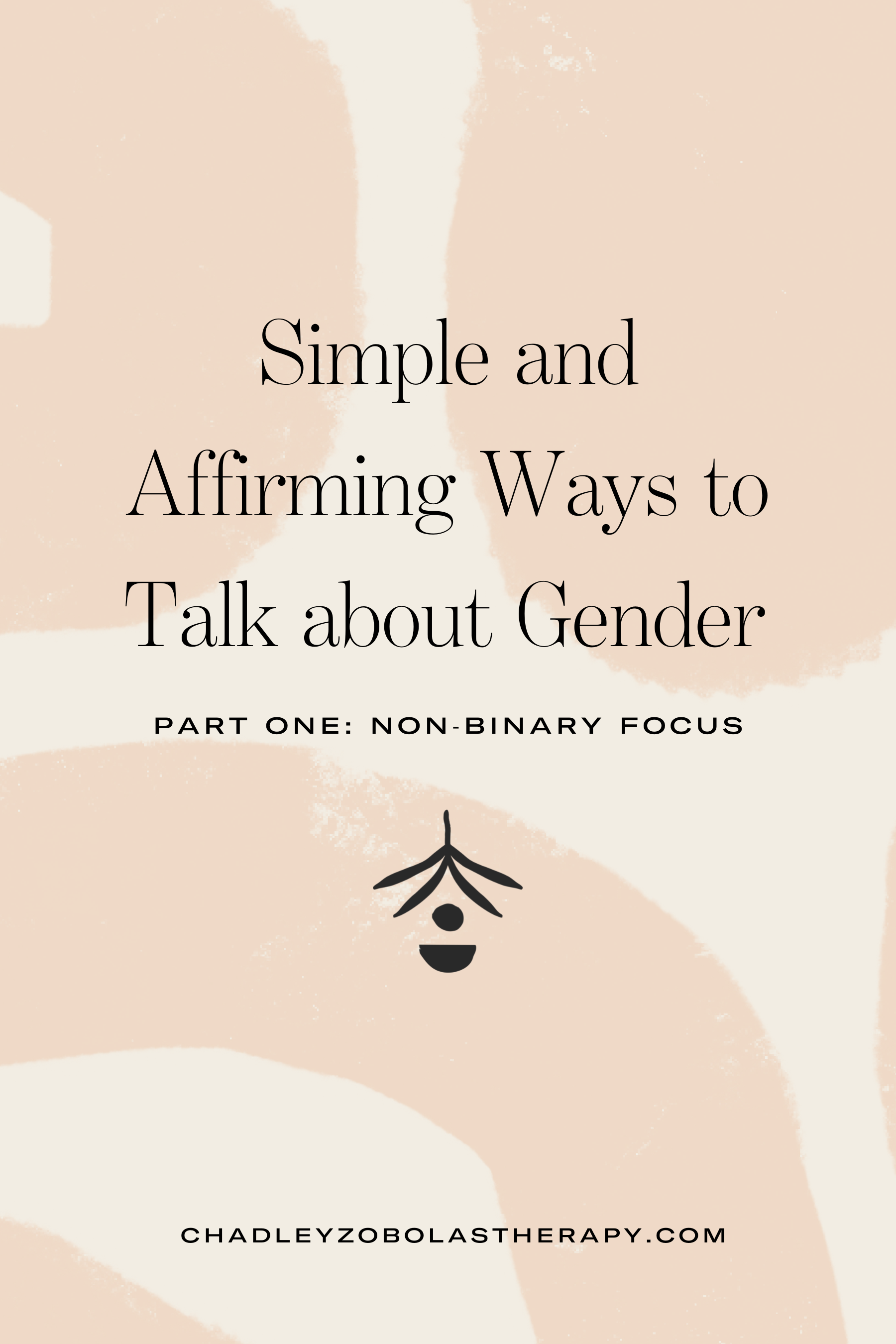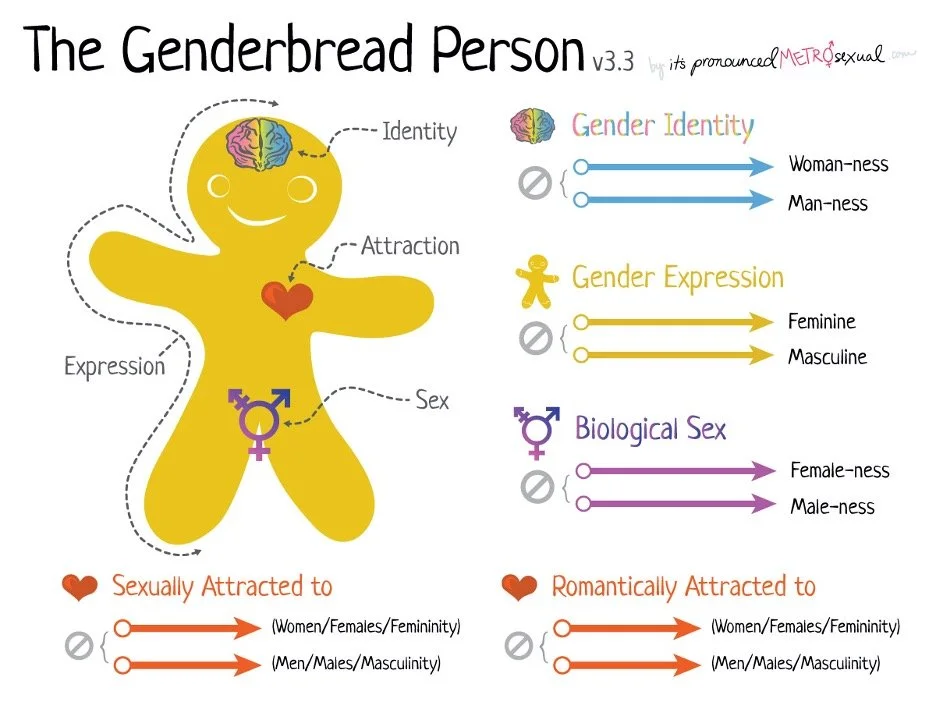Simple and Affirming Ways to Talk about Gender Part 1: Non-Binary Focus
By Jordan Kurtz, MA, LPCC, Associate Therapist
We use many identifiers on a daily basis to distinguish who we are in the world. What is our job? Our status as parents? Siblings? Our religion? Gender is another identity we hold, and it is important to consider how we and others identify along the gender continuum to ensure every human being is recognized appropriately and compassionately.
Breaking It Down
To begin, what is “gender”?
According to the Gender Spectrum and WHO organization, “gender” is a socially constructed label based on the norms, behaviors and roles most often associated with sex assigned at birth. At its core, gender is best defined by our “deeply held, internal sense of self”. This may diverge or converge with how our community, loved ones, strangers, and culture as a whole categorize individuals, though at large gender is most often compartmentalized as male, female, or nonbinary.
Understanding Identity with the Genderbread Person
The Genderbread person is a tool that helps isolate elements of identity further, and shows that we cannot assume anything about a person based on how they look.
The five components include: Gender Identity, Gender Expression, Biological Sex, Sexual Attraction, and Romantic Attraction. It is important to note that all these dimensions are considered spectrums, and one’s language about their gender can evolve with time.
Gender Identity:
As described above, gender is our intrinsic understanding of to what degree we recognize ourselves as or feel like a woman, man, neither, or both. It is how we think about where we fall on this masculine and feminine continuum and is not outwardly visible to others.
Gender Expression:
Expression relates to how we externally demonstrate our gender. This is associated with the name we choose and our pronouns, as well as how we dress, speak and behave.
Biological Sex:
Also referred to as “sex assigned at birth”, sex is a biological status based on reproductive anatomy. It is typically categorized as male, female, or intersex.
Sexual Attraction:
Sexual attraction refers to how we desire, show interest in, or share physical intimacy with another.
Romantic Attraction:
Romantic attraction refers to how we desire, show interest in, or share emotional intimacy with another.
Non-Binary & Related Terms
Now that we understand that gender is typically understood as a binary construct (strictly an either/or option of male/men/masculine or female/woman/feminine that corresponds with sex assigned at birth), let’s pivot to understand how to define non-binary and other associated terms.
Cisgender or Cis
An adjective that describes a person whose gender identity aligns with their assigned sex at birth (i.e. I was born with female reproductive anatomy, and I identify as a female/woman).
Transgender or Trans
An identity and umbrella term used to describe someone whose gender identity differs from sex assigned at birth (i.e. I was born with female reproductive anatomy, and I identify as a male/man).
Non-binary
In alignment with the model of the Genderbread Person above, “non-binary” refers to a spectrum or continuum of gender identities and expressions. It reflects a rejection of the notion that one belongs within a rigid male or female identity or an identity that matches biological sex. If someone is non-binary, they will likely use they/them/their pronouns** ( see pronoun section below).
Genderqueer
A person who does not identify as having a gender that can be categorized as male or female, one between or beyond genders, or some combination of genders.
Genderfluid
A person whose gender identity and expression moves between masculine and feminine or across the continuum.
Pangender
A person who identifies as all genders.
Two Spirit
A term used by Native and Indigenous people to reflect they embody both masculine and feminine spirits. It is sometimes also broadly used to describe Indigenous people with diverse sexual orientations, and its meaning is nuanced across various Indigenous subcultures.
Let’s Talk About Pronouns
Mary Emily O’Hara from the Gay and Lesbian Alliance Against Defamation (GLAAD) explains the importance of using correct pronouns as this, “Using the correct pronouns for trans and nonbinary [people] is a way to let them know that you see them, you affirm them, you accept them”.
Some non-binary folks use gender neutral pronouns to reflect their position outside the gender binary. Gender neutral pronouns include “they/them/theirs” or “ze/hir/hirs”. A person may also use a combination of pronouns that reflect their assigned sex at birth as well as their non-binary identity (i.e. she/they or him/they).
What is the right way to find out a person’s pronouns?
Incorporate stating your pronouns while introducing yourself to others. It signals that you are an individual who recognizes and supports gender identities outside of the binary. For example, “I am Pat Smith. I use she/her pronouns. What about you?”
Should everyone be asking everyone their pronouns at all times? Or does it depend on the setting?
Knowing each another’s pronouns ensures you have accurate information about another person, which is beneficial to all contexts. Merely guessing someone’s gender identity based on their external appearance or behaviors may prove to be harmful, and asking saves both you and other parties from embarrassment, judgement, and pain.
What if I use the wrong pronouns or misgender someone?
The best practice is to simply apologize and move on, as overcomplicating your explanation or justifying your mistake does not reflect willingness to learn. Apologizing and continuing ultimately indicates to the other that you care.
Common Related Questions
1. Is being transgender and non-binary the same thing?
Not necessarily. Remember that non-binary people can identify as being both a man and woman, somewhere in between, or totally outside these categories. Transgender implicates specifically that you do not identify with the gender you were assigned at birth. See the Rainbow Project link below for a more thorough explanation.
2. How do I know if my child is transgender or non-binary? How can my child know?
Children who do not conform to societal expectations about what boys and girls should look like or behave may be called “gender-expansive”. Being transgender or non-binary is one way of being gender-expansive, but not all gender expansive children are transgender or non-binary. Parents should teach themselves and their child about different identities and respect a child’s desire to explore identities as they develop.
3. How can I support someone who is transgender or non-binary?
Use gender identity inclusive language, including sharing your pronouns when meeting people. (link here: https://www.hrc.org/resources/glossary-of-terms)
Oppose discriminatory bills that target the transgender and non-binary community
Support inclusive public accommodations like gender-neutral bathrooms
Advocate for your state to require transgender and non-binary education in schools. Currently, only New Jersey, Colorado, Oregon, Illinois and California teach LGBTQ related history.
Support transgender and non-binary authors, actors, and public figures and media that promotes positive depictions of non-binary folks. Examples include Disclosure on Netflix and Transhood on HBO Max.
Local Resources for LGBTQIA+ Communities
The Center
Support groups, community building, case management, health services, and more.
One Colorado
Legislation and Advocacy
Queer*
Resource Directory


